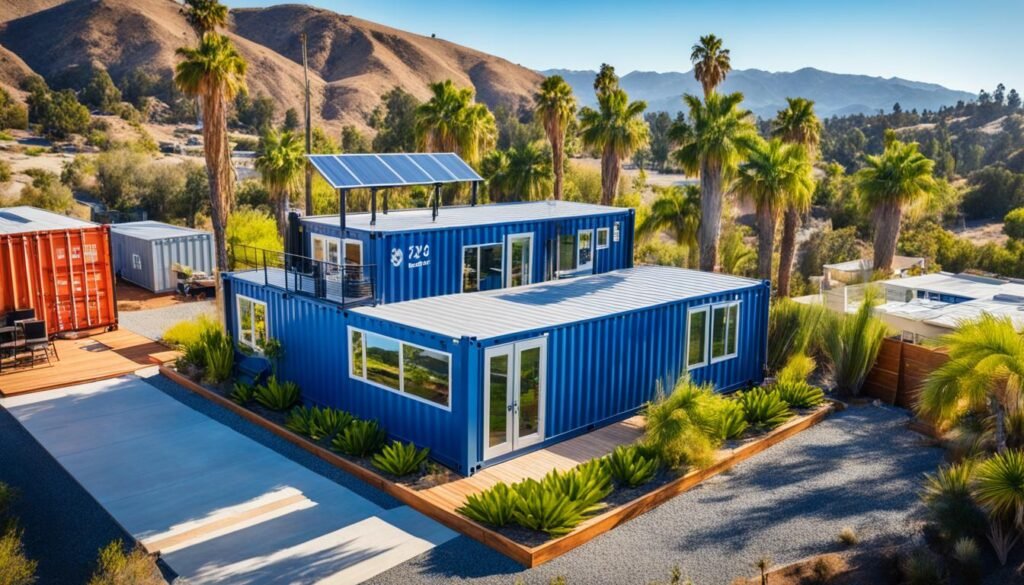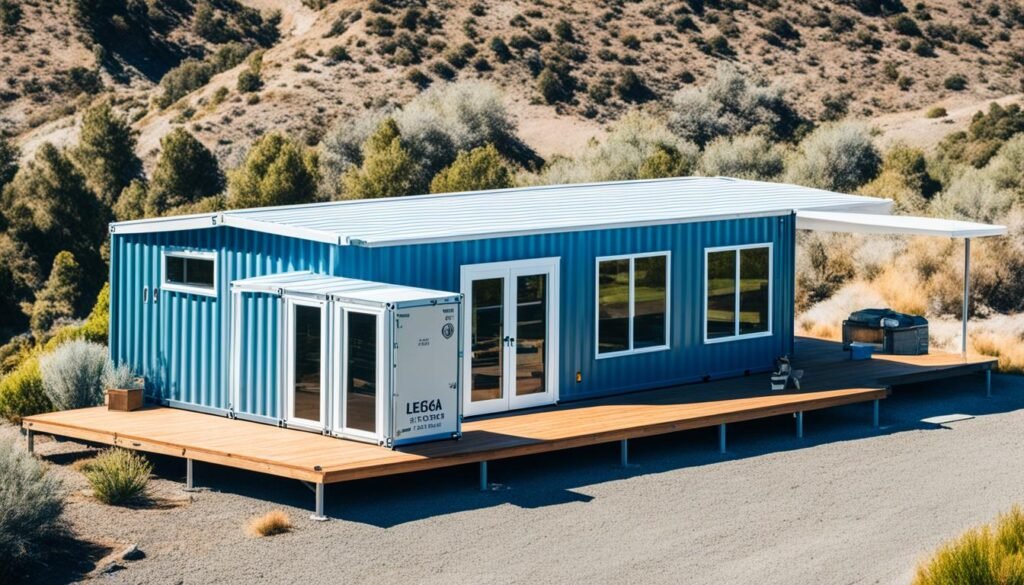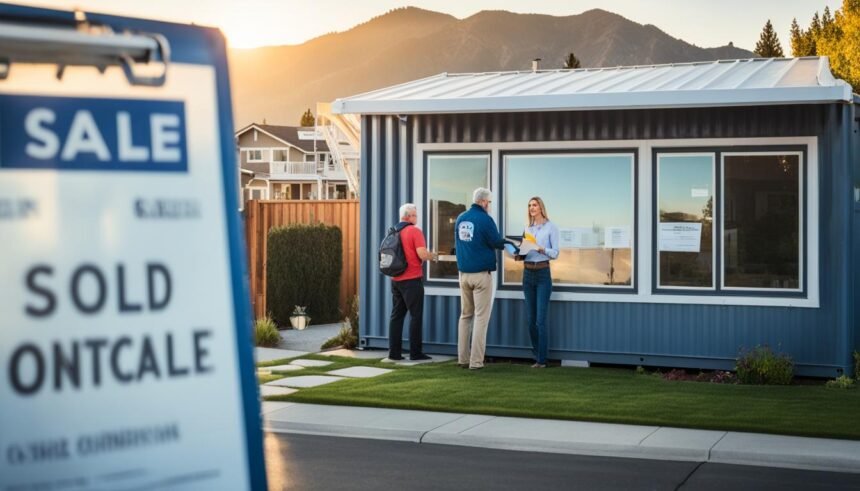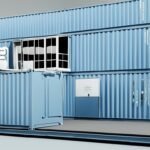California has always been at the forefront of innovative and sustainable housing options. One such option that has gained popularity in recent years is container homes. These unique dwellings, made from shipping containers, offer an affordable and eco-friendly alternative to traditional housing.
However, if you’re considering building a container home in California, it’s important to understand the legalities and regulations surrounding these types of structures. This article will delve into the specific laws and regulations that govern container homes in the state, providing you with the information you need to navigate the permitting process.
Key Takeaways:
- Container homes are a legal housing option in California.
- Specific building codes and regulations apply to container homes in the state.
- The permitting process is an essential step in building a container home in California.
- Zoning and land use regulations may impact the placement of container homes.
- Insurance and financing options are available for container home projects.
Understanding California’s Building Codes
Before delving into the legality of container homes in California, it’s important to understand the building codes that govern residential construction in the state. These codes are in place to ensure the safety, structural integrity, and adherence to certain standards for all types of homes, including container homes.
California follows a comprehensive set of building codes known as the California Building Standards Codes (Title 24). These codes outline the minimum requirements for construction, electrical systems, plumbing, accessibility, energy efficiency, and more.
When it comes to container homes, specific building code requirements may apply. While container homes can offer unique design opportunities and sustainability benefits, they still need to meet certain standards to ensure the safety and habitability of the structure.
In terms of structural considerations, container homes must meet the relevant provisions for strength, stability, and resistance to weather and seismic activity. Additional requirements may include insulation, ventilation, fire safety measures, and adequate access and egress.
It’s worth noting that building codes can vary slightly across different municipalities and jurisdictions within California. Some local jurisdictions may have specific zoning regulations or additional requirements for container homes.
“Building codes provide a standardized framework to ensure that homes meet safety and quality standards. Understanding and complying with these codes is essential when constructing a container home in California.”
To assist container home builders in understanding and adhering to the building codes, the California Department of Housing and Community Development (HCD) provides resources and guidelines. Their website offers detailed information on the building codes, including updates and frequently asked questions.
Moreover, consulting with a professional architect, engineer, or contractor experienced in container home construction is highly recommended. They can help navigate the specific requirements and ensure compliance with the relevant building codes.
| Benefits of Understanding Building Codes | Importance of Compliance |
|---|---|
|
|
By understanding and adhering to the building codes, container home builders can ensure their structures are safe, compliant, and built to last. It’s an essential step in realizing the vision of a container home in California.
Regulations for Container Home Construction
When embarking on the construction of a container home in California, it’s crucial to understand and adhere to the regulations that govern this unique form of housing. In this section, we’ll explore the specific requirements and considerations you need to keep in mind to ensure your container home complies with California container home laws and shipping container regulations.
One of the key aspects to consider when building a container home is structural integrity. While shipping containers are designed to withstand the rigors of transportation, modifications and conversions for residential use may require additional reinforcements. It’s important to consult with a qualified structural engineer to ensure that your container home meets local building codes and safety standards.
Considerations for Container Home Construction
Here are some important considerations to keep in mind:
- Foundation: The foundation of your container home plays a vital role in its stability and longevity. You may need to consult with a professional to determine the most suitable foundation type based on your location and soil conditions.
- Insulation: Proper insulation is crucial for maintaining comfortable indoor temperatures and reducing energy consumption. Consider using insulation materials that are suitable for container homes and comply with local building codes.
- Electrical and Plumbing: Container homes require electrical and plumbing systems that meet safety standards. Consult with licensed contractors to ensure that your electrical and plumbing installations comply with local regulations.
- Ventilation: Adequate ventilation is essential to prevent condensation and maintain healthy indoor air quality. You may need to incorporate windows, vents, or mechanical ventilation systems to achieve proper airflow.
- Fire Safety: Container homes should be equipped with adequate fire safety measures, such as smoke detectors, fire extinguishers, and fire-resistant materials. Consult with local fire codes to ensure compliance.
Permitting and Inspections
Before starting construction, you will need to obtain the necessary permits for building a container home in California. The permitting process typically involves submitting architectural plans, engineering calculations, and other documentation to demonstrate compliance with local building codes and regulations.
During the construction phase, you can expect inspections from local building officials to ensure that your container home meets safety and quality standards. These inspections typically cover structural elements, electrical and plumbing systems, insulation, and fire safety measures.
By understanding and following the regulations for container home construction in California, you can ensure that your project is compliant with the law and meets the necessary safety standards. This will not only give you peace of mind but also contribute to the long-term sustainability and livability of your container home.
Permitting Process for Container Homes in California
Obtaining the necessary permits is a crucial step in building a container home in California. To ensure compliance with the state’s regulations, it’s important to understand the permitting process and the documentation required.
When applying for permits for your container home, you’ll typically need to provide detailed plans and specifications to the local building department. These plans should include information on the structural integrity, electrical and plumbing systems, and insulation of the container home. Additionally, you may be required to submit a site plan indicating the placement of the container on your property.
In some cases, you might need to engage the services of an architect or engineer to review and stamp your plans, especially if modifications are made to the container structure. This step ensures that your container home meets the necessary building codes and safety standards.
Depending on the location and local jurisdiction, the permitting process can vary. It’s essential to check with your local building department to determine the specific requirements and fees associated with obtaining permits for your container home project.
Permitting Documentation Checklist:
- Architectural plans
- Structural plans
- Electrical plans
- Plumbing plans
- Insulation plans
- Site plan
- Approval from an architect or engineer (if required)
Once you have gathered all the necessary documentation, you can submit your permit application to the local building department. The approval process may take some time, so it’s important to plan accordingly and allow for any potential delays.
Remember, each local jurisdiction may have its own specific building codes and regulations, so it’s crucial to consult with the local authorities and professionals experienced in container home construction.
With the proper permits in hand, you can proceed with confidence knowing that your container home project is in compliance with the requirements set forth by the state.
Building a container home allows you to create a unique and sustainable living space. However, it’s vital to respect the legal framework in place, obtaining the necessary permits to ensure the safety and quality of your container home.
Zoning and Land Use Regulations
The location and placement of container homes are subject to zoning and land use regulations in California. These regulations play a crucial role in determining where you can build a container home and what restrictions may apply to its design and use.
Understanding the zoning laws and land use regulations in your specific area is essential before embarking on a container home project. Failing to comply with these regulations can result in fines, forced removal, or legal complications.
Each city and county in California has its own zoning regulations, which categorize areas for different types of land use, such as residential, commercial, or industrial. Some areas may have specific restrictions on residential structures, including container homes.
Researching Zoning Codes
When planning to build a container home, start by researching the zoning codes and contacting the local planning or zoning department in your area. They can provide you with information about the specific zoning regulations that apply to your property.
Consider the following when researching zoning codes:
- Applicable zoning districts: Determine which zoning district your property falls under and what types of structures are allowed in that district.
- Use classification: Check if container homes are allowed as a residential use in your intended location. Some areas may only allow container homes as accessory dwelling units, while others may classify them as single-family homes.
- Setback requirements: Understand the required distances between your container home and property lines or other structures. Setbacks help ensure safety, privacy, and aesthetic harmony within the neighborhood.
- Maximum height and size: Verify if there are any limitations on the height or overall size of the container home that you plan to build.
- Historic or conservation areas: If your property is located within a historic or conservation district, there may be additional regulations and preservation requirements that you must adhere to.
By thoroughly researching the zoning regulations, you can determine whether your property is suitable for a container home and understand any potential limitations or modifications you may need to make to comply with the regulations.
Conditional Use Permits
In some cases, your property may not be zoned for container homes, but it may be possible to obtain a conditional use permit. Conditional use permits provide an exception to the zoning regulations for specific projects that meet designated criteria.
If you discover that your property’s zoning code does not explicitly allow container homes, consider consulting with the local planning department to explore the possibility of obtaining a conditional use permit. Be prepared to provide detailed plans and justifications for your container home project to support your permit application.
Architectural Review Boards and Homeowners’ Associations
In addition to zoning regulations, you may also need to consider the requirements of architectural review boards or homeowners’ associations (HOAs). These entities have their own guidelines and restrictions that govern the design and appearance of structures within their jurisdiction.
If your property falls under the jurisdiction of an architectural review board or HOA, ensure that your container home plans comply with their regulations. This may involve submitting architectural drawings, materials samples, and other documentation for review and approval.
| Key Considerations for Zoning and Land Use Regulations | Impacts on Container Homes |
|---|---|
| Specific zoning districts | Determine where container homes are allowed and which zoning district your property falls under. |
| Use classification | Check if container homes are allowed as a residential use and whether they require additional permits or meet specific criteria. |
| Setback requirements | Understand the distance your container home must be set back from property lines and neighboring structures. |
| Maximum height and size limitations | Verify any restrictions on the height or overall size of your container home. |
| Historic or conservation areas | Consider additional regulations if your property is located within a historic or conservation district. |
Challenges and Considerations for Container Homeowners
While container homes offer unique advantages such as affordability and sustainability, they also present certain challenges that homeowners need to be aware of. Here are some considerations to keep in mind when building and living in a container home in California:
1. Building Codes and Regulations
California container home laws and shipping container regulations dictate specific requirements for construction and safety. It’s crucial to understand and comply with these building codes to ensure the legality and structural integrity of your container home.
2. Insulation and Ventilation
Containers are made of metal, which can amplify temperature extremes. Proper insulation is essential to maintain comfortable living conditions inside the home. Additionally, adequate ventilation is necessary to prevent condensation and ensure good air quality.
3. Plumbing and Electrical Systems
Installing plumbing and electrical systems in a container home requires careful planning to ensure functionality and compliance with California’s regulations. It’s recommended to work with professionals who have experience in container home construction to ensure the safety and efficiency of these systems.
4. Space and Layout
Container homes typically have limited space compared to traditional houses. Efficient space utilization and thoughtful layout design are crucial to maximize functionality and comfort. Consider factors such as storage, furniture placement, and multi-purpose areas to make the most of the available space.
5. Durability and Maintenance
Although shipping containers are built to withstand harsh conditions, they still require maintenance to prevent rust and corrosion. Regular inspections and repairs are necessary to ensure the long-term durability of the structure. Additionally, the exterior may need to be repainted or coated for aesthetic purposes and to protect against weathering.
6. Financing and Insurance
Obtaining financing for a container home may be more challenging than for a traditional house. It’s essential to research lenders who specialize in alternative home construction and understand the unique aspects of container homes. Similarly, insurance coverage for container homes may require specialized policies, so it’s important to consult with insurance providers who have experience in this area.
Building and living in a container home in California can be a rewarding experience, but it’s crucial to be aware of the challenges and considerations involved. By educating yourself about the relevant laws and regulations and seeking guidance from professionals, you can overcome these challenges and create a comfortable and unique living space.
| Challenges | Considerations |
|---|---|
| Building codes and regulations | Comply with California container home laws and shipping container regulations |
| Insulation and ventilation | Ensure proper insulation and ventilation to maintain comfortable living conditions |
| Plumbing and electrical systems | Plan and install systems that meet regulatory requirements and ensure efficiency and safety |
| Space and layout | Maximize space utilization and design a functional layout |
| Durability and maintenance | Maintain the structure and protect against rust, corrosion, and weathering |
| Financing and insurance | Research lenders and insurance providers with expertise in container homes |
Insurance and Financing Options for Container Homes
When building a container home in California, it’s essential to consider the insurance and financing options available to protect your investment and make the project financially feasible. In this section, we’ll explore some key considerations and resources to help you navigate this aspect of container home ownership.
Insurance for Container Homes
Insuring a container home in California may require a specialized insurance policy that takes into account the unique characteristics of this type of dwelling. It’s crucial to work with an insurance provider who understands the specific risks associated with container homes and can offer the appropriate coverage options.
When selecting an insurance policy for your container home, consider factors such as:
- The value of your container home and its contents
- The location of your container home
- Protection against natural disasters and other hazards
- Liability coverage in case of accidents or injuries on your property
By thoroughly assessing your insurance needs and working with an experienced insurance agent, you can ensure that your container home is adequately protected.
Financing Options for Container Homes
Securing financing for a container home project in California may require some research and creativity, as this type of construction may not conform to traditional mortgage lending standards. However, there are financing options available for container homes in the state.
Consider the following financing avenues for your container home project:
- Personal Loans: You may qualify for a personal loan to cover the costs of building or purchasing a container home. Personal loans typically have more flexible lending criteria.
- Home Equity Loans or Lines of Credit: If you already own property in California, you can leverage the equity in your home to secure a loan or line of credit for your container home project.
- Specialized Lenders: Some financial institutions specialize in providing loans specifically for alternative and unique housing projects like container homes. These lenders understand the specific challenges and opportunities associated with container home financing.
It’s vital to research and compare different financing options to find the one that best suits your needs and budget.

Keep in mind that insurance and financing requirements for container homes can vary, so it’s essential to consult with insurance agents, lenders, and financial professionals who have experience in this niche market. They can provide tailored advice and guidance based on your specific container home project and financial situation.
Showcasing Successful Container Home Projects in California
To inspire and give you a sense of what’s possible, here are some exceptional container home projects in California. These examples demonstrate the innovative design and impressive functionality that can be achieved with container homes.
Modern Marvel in Malibu
This stunning container home, nestled on the sandy shores of Malibu, showcases the seamless integration of industrial aesthetics with luxurious comfort. The use of floor-to-ceiling windows and open-concept living spaces allows for breathtaking ocean views and abundant natural light. The interior boasts a contemporary design, featuring sleek finishes, high-end appliances, and spacious living areas. This project serves as a prime example of the limitless potential of container homes in creating sophisticated coastal retreats.
Urban Oasis in San Francisco
Located in the heart of San Francisco, this container home project defies convention with its vertical design. Strategically stacked containers create multiple levels, optimizing living space in the midst of a bustling cityscape. The design incorporates rooftop gardens, adding a touch of greenery to the urban environment. Inside, the home offers a harmonious blend of modernity and warmth, with stylish finishes, smart home technology, and efficient space utilization. This project showcases the ingenuity of container homes in urban settings.
Rustic Retreat in the Redwoods
Tucked away in the serene beauty of California’s redwood forests, this container home project exemplifies rustic charm and eco-conscious living. The exterior blends seamlessly with the surrounding forest, while the interior features reclaimed wood finishes and cozy furnishings. Large windows provide breathtaking views of the forest canopy and merge the indoor and outdoor spaces. This project demonstrates how container homes can coexist harmoniously with nature, offering a tranquil escape from the busy world.
These extraordinary container home projects in California illustrate the myriad possibilities for transforming shipping containers into stunning, functional dwellings. Whether you seek a contemporary beachfront retreat, an urban sanctuary, or a nature-inspired hideaway, container homes offer limitless potential to create unique and sustainable living spaces.
| Project Name | Location | Design Style |
|---|---|---|
| Modern Marvel in Malibu | Malibu | Contemporary |
| Urban Oasis in San Francisco | San Francisco | Modern/Urban |
| Rustic Retreat in the Redwoods | Redwood Forests | Rustic/Eco-friendly |
Resources and Support for Container Home Builders in California
Building a container home in California can be an exciting but challenging endeavor. Fortunately, there are numerous resources and support available to help you navigate the process and turn your container home dream into a reality. Whether you need guidance on obtaining permits, finding reputable contractors, or connecting with like-minded individuals, these resources can provide valuable assistance.
Organizations
Several organizations in California are dedicated to supporting container home builders and enthusiasts. These organizations offer a wealth of information, resources, and networking opportunities:
- California Container Home Association (CCHA)
- Container Homes California (CHC)
Forums and Online Communities
Participating in online forums and communities can connect you with experienced container home builders who can offer advice, share their experiences, and provide valuable insights. Here are some popular online platforms where you can engage with the container home community:
- Container Home World Forum
- Container Living Forum
Architects and Contractors
Working with professionals who specialize in container home construction can streamline your building process and ensure compliance with California’s container home laws and regulations. These architects and contractors have extensive experience in designing and building container homes:
- Smith & Smith Architects
- Green Living Builders
Online Design Tools and Resources
Designing your container home requires careful planning and consideration. Fortunately, there are online tools and resources available to assist you in the design process. These tools can help you visualize your ideas and create accurate plans for your container home:
- Container Home Designer
- 3D Warehouse
Books and Publications
For those seeking in-depth knowledge and inspiration, there are several books and publications available that explore the world of container home construction. These resources can provide valuable insights and ideas for your container home project:
- The Container Home Handbook by Andrew Morrison
- Container Atlas: A Practical Guide to Container Architecture

Remember, building a container home in California requires careful planning, adherence to regulations, and collaboration with professionals. By leveraging the resources and support available, you can navigate the process confidently and create a beautiful container home that meets all legal requirements.
Conclusion
In conclusion, container homes are indeed legal in California, but they are subject to specific regulations and permitting requirements. It is crucial to understand and adhere to these laws to ensure a smooth process for building and living in a container home in the Golden State.
California container home laws outline the necessary steps and guidelines for constructing container homes to ensure they meet structural and safety requirements. These laws also govern the permitting process, which involves submitting the required documentation and paying any associated fees.
Additionally, container home builders in California need to consider zoning and land use regulations. These regulations determine where container homes can be located and placed on a property, taking into account factors such as property size and neighboring structures.
By staying informed about California container home laws and regulations, aspiring container home owners can navigate the process successfully and enjoy the unique advantages that container homes offer, such as affordability and sustainability.








